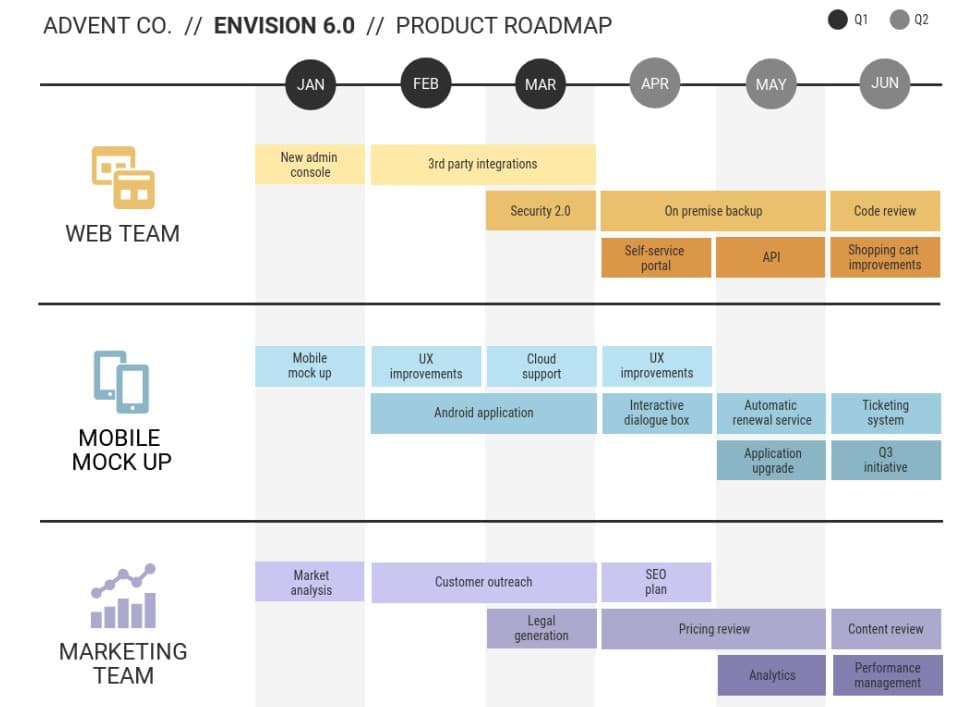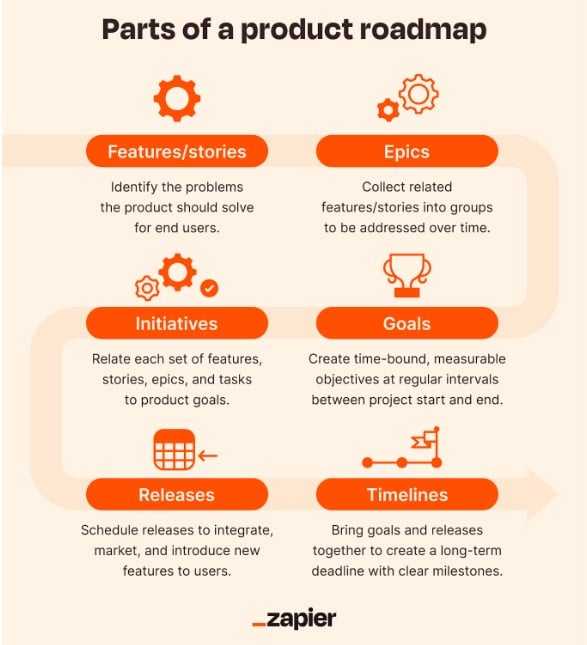In today’s fast-paced and ever-changing business landscape, agile practices have become the norm for software development teams. Development has rightfully shifted towards incremental, iterative workflows to adapt to changing market conditions and customer needs quickly. However, effective planning remains a challenge for product teams, as they strive to strike the right balance between focus and flexibility. This challenge is particularly pronounced when it comes to managing feature roadmaps, which serve as the central guide for each sprint or iteration.
Achieving the optimal balance between providing enough detail to guide the development team while maintaining the necessary agility and adaptability is a delicate task. Too much specificity can lead to rigidity and inflexibility, making it difficult to respond to changes and incorporate learnings from each iteration. On the other hand, too little detail can result in a lack of clarity and direction, hindering prioritization, alignment, and the efficient use of resources.
This article explores the art of managing feature roadmaps with just enough detail to guide iterative development cycles effectively. We will discuss the purpose and benefits of feature roadmaps, the challenges associated with maintaining the optimal level of granularity, and the principles and techniques that support disciplined yet responsive roadmap management. The ultimate goal is to provide guidance that maximizes agility and team productivity through iterative feature delivery while ensuring alignment with strategic objectives.
Understanding feature roadmaps
A feature roadmap acts as the core development guide, deconstructing initiatives and themes into focused deliverables for each sprint or iteration. It serves as the lynchpin between long-term product vision and iteration planning, bridging the gap between strategic objectives and tactical execution. Consequently, feature roadmaps require a judicious balance of detail—too much rigidity hinders responsiveness, while too little abstraction lacks the necessary direction.
Well-calibrated feature roadmaps enhance iterative workflows by providing:
- Clear sprint-level guidance on targeted outcomes and deliverables.
- A direct connection between strategic objectives and development priorities.
- Flexibility to adapt features to learnings and insights gathered throughout each iteration.
- Organized visibility into progress against initiatives and themes.
- Optimal resource allocation through a clear understanding of feature scope and dependencies.
For product teams building incrementally through continuous discovery and adaptation, feature roadmaps are essential for maintaining alignment while fostering the necessary agility to respond to changes effectively.
Image Source: Product roadmaps: Complete guide [with templates] | Zapier
Finding the right balance: Just enough detail
Achieving the sweet spot between too much and too little detail in feature roadmaps is a challenging endeavor. Each extreme introduces its own set of risks and drawbacks:
Too much detail:
- Roadmaps lose flexibility, hindering the ability to make course corrections as needed.
- Significant changes become tedious and time-consuming due to widespread impacts across the roadmap.
- Over-engineering roadmap plans hampers the team’s ability to respond to changes quickly and effectively.
Too little detail:
- Roadmaps risk ambiguity and lack the necessary strategic context for effective decision-making.
- Prioritization becomes guesswork without adequate scoping and understanding of feature impacts.
- Lack of coordination and alignment due to insufficient decomposition of initiatives into actionable features.
To empower incremental progress and foster an environment of continuous improvement, product managers must strike a balance between clarity and fluidity—providing high-level yet actionable planning guidance that can be refined and adapted through iterative discovery and incorporation of learnings and feedback. However, determining the optimal level of detail is an ongoing process that requires experimentation and adjustment as the team’s understanding of the product and market evolves over time.
Principles for managing feature roadmaps
Adhering to the following principles can help product teams maximize the adaptability of their feature roadmaps while maintaining the necessary guidance and alignment atop iterative development workflows:
- Align with product strategy and vision: Ensure that the features included in the roadmap are clearly linked back to the overarching strategic objectives and product vision. This alignment helps maintain focus and prioritize initiatives that drive the most significant impact.
- Prioritize based on customer value and business impact: Rank and prioritize features using quantifiable metrics based on measurable customer benefits and business impacts, rather than relying solely on advocacy or personal interest.
- Maintain a flexible and iterative approach: Regularly review and refine the feature roadmap to adapt to new learnings, insights, and changing market conditions as the team’s understanding of the product and customer needs evolves.
- Collaborate with cross-functional teams: Involve cross-functional teams, including development, design, marketing, and customer support, in the roadmap planning process. This holistic input enhances the team’s understanding of feature feasibility, dependencies, and alignment across the organization.
- Continuously gather and incorporate feedback: Actively solicit and incorporate feedback from customers, stakeholders, and team members throughout the roadmap planning and execution process. Evolving perspectives and insights foster roadmap relevance and prevent reliance on assumptions alone.
By staying customer-centric and outcome-focused, product teams can optimize the appropriate level of abstraction in their feature roadmaps while retaining the necessary agility to adapt to changing contexts and priorities.
Best practices for effective feature roadmap management
Implementing the following best practices can facilitate effective day-to-day management of feature roadmaps, ensuring that the development work remains aligned with evolving understanding and priorities:
- Define feature scope and objectives: Clearly define the scope and objectives of each feature included in the roadmap. Unambiguous descriptions and well-articulated goals enable accurate estimation, efficient resource allocation, and transparent progress tracking.
- Prioritize based on market needs: Leverage data-centric prioritization techniques that promote the delivery of features with the highest customer value and market impact, rather than following the path of least resistance.
- Break down features into small, iterative chunks: Break down larger features into smaller, manageable components or user stories. This granular decomposition clarifies the work involved, improves estimation precision, and allows for faster adaptation and course correction as needed.
- Use visuals and storytelling: Employ visual aids and storytelling techniques to communicate feature roadmaps effectively. Vivid illustrations and narratives drive consensus, alignment, and stakeholder engagement better than dense textual descriptions.
- Regularly review and adjust roadmaps: Establish a cadence for regular reviews and adjustments of the feature roadmap. Continuous reassessment and refinement help sustain the roadmap’s relevance and adaptability as the team’s understanding of the product, market, and customer needs deepens over time.
By following these best practices, product teams can ensure that their feature roadmaps serve as living documents that guide iterative development cycles while remaining responsive to changes and learnings.
Feature prioritization techniques
Effective prioritization of features is a critical aspect of roadmap management, as it directly impacts the team’s ability to deliver maximum value to customers and the business. When prioritizing features, product teams must consider a multitude of strategic, business, qualitative, and quantitative factors. Combining various prioritization techniques can help ensure a balanced and well-informed decision-making process:
- Opportunity scoring and value analysis: Quantify the expected value, impact, and effort associated with each feature using scoring models or value analysis frameworks. This data-driven approach supports evidence-based decision-making and helps prioritize features based on their potential to drive meaningful outcomes.
- Kano model and customer satisfaction analysis: Leverage the Kano model or customer satisfaction analysis techniques to distinguish between critical issues, performance factors, and “nice-to-have” features. This approach helps optimize outcomes by focusing on the features that have the most significant impact on customer satisfaction and retention.
- Cost-benefit analysis and return on investment (ROI): Quantify the tangible benefits and costs associated with each feature to calculate its potential return on investment (ROI). This analysis helps rationalize investment decisions by considering the financial impact and potential value creation, rather than relying solely on subjective evaluations.
- Lean and agile prioritization frameworks: Adopt lean and agile prioritization frameworks, such as Weighted Shortest Job First (WSJF) or RICE (Reach, Impact, Confidence, Effort), to manage complexity and align teams around consistent prioritization criteria. These customizable frameworks provide structured approaches to evaluating and ranking features based on predefined metrics and weights.
By combining these techniques and leveraging both quantitative and qualitative data, product teams can make informed and well-rounded decisions when prioritizing features, ensuring that their roadmaps align with customer needs, business objectives, and strategic priorities.
Tools and techniques for managing feature roadmaps
To effectively manage feature roadmaps throughout their entire lifecycle, product teams can leverage a variety of purpose-built software tools and techniques:
- Roadmapping tools (e.g., Aha!, ProductPlan, Roadmunk): Dedicated roadmapping tools facilitate visual roadmap creation, feature prioritization, dependency management, and progress tracking. These tools help communicate roadmaps clearly to stakeholders and provide real time tracking.
- Agile project management tools (e.g., Jira, Trello, Asana): These tools are designed to track the execution of roadmapped features, providing a centralized platform for managing tasks, issues, and dependencies related to each feature. They seamlessly integrate with development workflows, enabling teams to maintain visibility into progress and collaborate effectively.
- Collaborative ideation and feedback tools: Platforms such as UserVoice, Canny, or Productboard enable teams to capture early customer feedback, feature requests, and ideas. These tools help visualize conceptual designs, gather input from stakeholders, and disseminate understanding across the organization, fostering a customer-centric approach to roadmap planning.
- Analytics and data insights tools: By leveraging analytics and data insights tools, product teams can transform raw data into meaningful strategic or tactical perspectives. These insights can inform feature prioritization, validate assumptions, and provide a data-driven foundation for roadmap planning and decision-making.
Adapting a combination of fit-for-purpose tools and techniques tailored to the team’s specific needs and workflows can unlock the full potential of feature roadmaps within agile development environments. This integrated approach facilitates collaboration, communication, and alignment across cross-functional teams, ensuring that roadmaps remain relevant and responsive to changing circumstances.
Challenges and considerations
While adopting an agile approach to feature roadmap management can empower product teams and foster iterative, customer-centric development, it also introduces its own set of challenges and considerations that require prudent management:
- Lack of alignment and communication: Without clear alignment and effective communication among stakeholders, changes or pivots in the roadmap can lead to delays, inefficiencies, and misaligned expectations, hindering the team’s ability to deliver value effectively.
- Scope creep and uncontrolled growth: A lack of discipline and focus can result in scope creep, where features accumulate beyond the team’s capacity to deliver or address the root issues effectively. This risk can undermine the iterative and incremental nature of the development process.
- Resistance to change and evolution: While flexibility is a core tenet of agile development, some stakeholders may resist change and insist on adhering rigidly to historical plans, even when evidence suggests the need for course correction or improvement. Overcoming this resistance is crucial to fully realizing the benefits of an iterative approach.
- Insufficient stakeholder involvement: Excluding customers, end-users, or other key stakeholders from the roadmap planning and feedback process can lead to misalignment between the features being developed and the actual needs and pain points of the target audience.
By proactively addressing these challenges and fostering an environment of continuous learning, open communication, and prudent change management, product teams can optimize the promised benefits of agile feature roadmap management. Ongoing collaboration, research, and the incorporation of feedback practices are essential to strike the right balance between guidance, relevance to customer needs, and flexibility in the face of change.
Conclusion
In the rapidly evolving world of software development, balancing abstraction with sufficient clarity and priority guidance is essential for optimizing iterative delivery aligned with evolving needs. When managed with discipline, collaboration, continuous research, and the incorporation of feedback, feature roadmaps serve as powerful tools guiding frequent, incremental progress towards business objectives.
Early adopters of agile feature roadmap management practices have demonstrated substantial benefits, including improved customer satisfaction, faster time-to-market, and enhanced adaptability to changing market conditions. By mastering the dynamics of maintaining just enough detail to provide direction while fostering flexibility, product teams can sustain the value of their roadmaps across engineering workflows, ensuring that they remain relevant, responsive, and aligned with customer needs.
As agile methodologies continue to gain traction and customer expectations evolve rapidly, the ability to manage feature roadmaps effectively will become an increasingly critical competitive advantage. By embracing the principles and best practices outlined in this article, organizations can position themselves at the forefront of iterative, customer-centric product development, driving innovation and delivering exceptional experiences that resonate with their target audiences.










